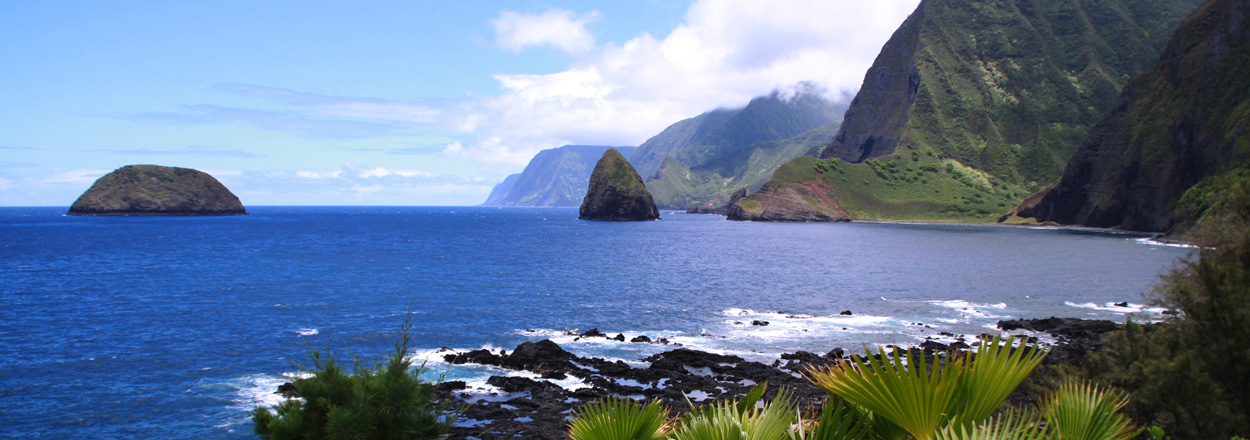Although the Hawaiian island of Molokai is tiny (it covers only about 260 square miles), it boasts a wealth of attractive features including beautiful beaches, lush forests, tons of local culture and history and, of course, that quintessential laid-back island lifestyle.
Molokai Basics
- Getting there –Travelers arriving by plane will fly into the Molokai Airport located in the central region of the island. Nautical-loving travelers can also visit the islands via cruise ship or ferry where they will dock at Kaunakakai Harbor.
- Location – Molokai is Hawaii’s second-smallest island measuring just 38 miles long and 10 miles wide. The island is divided into three major regions: Central Molokai, West End and East End.
- Climate – Molokai is blessed with warm weather all year round with temperatures ranging from the mid-70s to lower 80s.
- Currency – Since Hawaii is part of the United States their currency is the U.S. dollar.
- Language – Fun fact: Hawaii is the only American state with two official languages: Hawaiian and English. In addition to speaking in two native tongues, many Hawaiians also use a form of slang called Pidgin.
Lodging
Molokai is considered the least developed of the Hawaiian islands and features only one larger resort and a few hotels in the main city of Kaunakakai. The resort in question is the Hotel Molokai, an escape from all things mainstream hidden on the beach of Kamiloloa. Hotel Molokai is Polynesian-themed complete with a village of modern bungalows and is located just five minutes from the island’s most bustling area, the very small city of Kaunakakai. In addition to Hotel Molokai, visitors can choose from a number of condos, vacation rentals or private cottages.
Food
Authentic is the key word when it comes to food on the island of Molokai, meaning travelers looking for big chains and five-star dining will leave disappointed. But fret not, while there’s no sign of the golden arches, the local fare proves to be delightful. For sweet treats and breakfast goodies, visitors must stop by the Kanemitsu Bakery to try their fabulous cinnamon rolls and famous hot bread. Mid-day meals are best served at the popular Molokai Pizza café and the Ono Fish and Shrimp Food Truck for a quick and tasty bite. And when it comes to upscale dining, past travelers advise a meal at Hiro’s Ohana Grill for a romantic evening paired with seafood and steak.
Fun
- Adventure – Those looking for great hiking need look no further than Palaau State Park, a 233-acre state park home to Kaule O Nanahoa (the phallus of Nanahoa), a sacred site once believed to increase fertility. Alright, alright, even if travelers aren’t looking to make a mini-me, Palaau is still a fantastic spot for scenic views of the sparkling Pacific Ocean and dense vegetation. Another spot worth checking out is the Kapuaiwa Coconut Grove, an ancient Hawaiian site once owned by King Kamehameha. Although the grove is privately owned, it’s visible off of the Mauna Loa Highways and makes for the perfect background for any vacation selfie.
- Entertainment – Did you know that coconuts can travel via the U.S. Postal Service? That’s right, at the Post-A-Nut, Hoolehua Post Office, travelers can decorate and mail a custom-painted coconut to their friends and family anywhere around the world. Talk about a nutty souvenir. While Molokai isn’t big on nightlife, there are a few spots for live music and drinks for those looking for some fun after the sun goes down such as island favorite Paddlers Restaurant and Bar. Not looking for booze? Molokai also has a 500-acre coffee farm that tourists can visit for a small fee.
History and Culture
- Halawa Valley – Settled by ancient Polynesians in 650 AD, the Halawa Valley is one of the oldest-known Hawaiian settlements on the island of Molokai. Hidden heiau (places of worship) live simultaneously with rushing waterfalls and beautiful vistas in this historic area. The road to Halawa Valley passes several important landmarks like the Hawaiian Fishponds, Kaluaaha Church and Kumimi Beach.
- Kalaupapa National Historic Park – Located on the isolated peninsula of Molokai’s north coast, victims of leprosy were forced into isolation at what is now Kalaupapa National Historic Park from 1866 to 1969. Upon hearing about the isolated residents, Belgian missionary Saint Damien left his home to care for the residents in 1873. Father Damien eventually fell ill to the disease and was buried on-site where his grave can still be visited today. Traveler’s should be warned that the trek to this historic site consists of a challenging 3.5 mile hike up a steep trail with uneven surfaces so it’s important for visitors to be realistic about their physical fitness levels to ensure a happy and safe adventure. Kalaupapa is in an extremely isolated area and is not accessible by car.
- Hawaiian Fishponds – A look at early Hawaiian ingenuity, Molokai has around 60 rock-wall fishponds aging between 700 to 800 years along the south shore. East of Kaunakakai is the Alii Fishpond, one of the most impressive ponds in the area.






comments